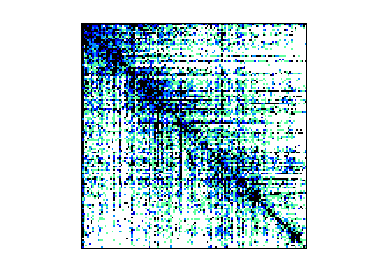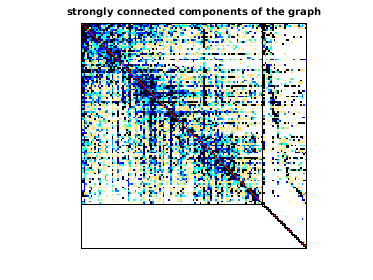SNAP/soc-sign-bitcoin-otc
SNAP network: Bitcoin OTC trust weighted signed network
| Name | soc-sign-bitcoin-otc |
|---|---|
| Group | SNAP |
| Matrix ID | 2791 |
| Num Rows | 5,881 |
| Num Cols | 5,881 |
| Nonzeros | 35,592 |
| Pattern Entries | 35,592 |
| Kind | Directed Weighted Temporal Graph |
| Symmetric | No |
| Date | 2016 |
| Author | S. Kumar, F. Spezzano, V.S. Subrahmanian, C. Faloutsos |
| Editor | J. Leskovec |
| Download | MATLAB Rutherford Boeing Matrix Market |
|---|---|
| Notes |
SNAP (Stanford Network Analysis Platform) Large Network Dataset Collection,
Jure Leskovec and Anrej Krevl, http://snap.stanford.edu/data, June 2014.
email: jure at cs.stanford.edu
Bitcoin OTC trust weighted signed network
https://snap.stanford.edu/data/soc-sign-bitcoin-otc.html
Dataset information
This is who-trusts-whom network of people who trade using Bitcoin on a
platform called Bitcoin OTC (http://www.bitcoin-otc.com/). Since Bitcoin
users are anonymous, there is a need to maintain a record of users'
reputation to prevent transactions with fraudulent and risky users. Members
of Bitcoin OTC rate other members in a scale of -10 (total distrust) to +10
(total trust) in steps of 1. This is the first explicit weighted signed
directed network available for research.
Dataset statistics
Nodes 5,881
Edges 35,592
Range of edge weight -10 to +10
Percentage of positive edges 89%
Similar network from another Bitcoin platform, Bitcoin Alpha, is available
at https://snap.stanford.edu/data/soc-sign-bitcoinalpha.html (and as
SNAP/bitcoin-alpha in the SuiteSparse Matrix Collection).
Source (citation) Please cite the following paper if you use this dataset:
S. Kumar, F. Spezzano, V.S. Subrahmanian, C. Faloutsos. Edge Weight
Prediction in Weighted Signed Networks. IEEE International Conference on
Data Mining (ICDM), 2016.
The following BibTeX citation can be used:
@inproceedings{kumar2016edge,
title={Edge weight prediction in weighted signed networks},
author={Kumar, Srijan and Spezzano, Francesca and Subrahmanian, VS
and Faloutsos, Christos},
booktitle={Data Mining (ICDM), 2016 IEEE 16th Intl. Conf. on},
pages={221--230},
year={2016},
organization={IEEE}
}
The project webpage for this paper, along with its code to calculate two
signed network metrics---fairness and goodness---is available at
http://cs.umd.edu/~srijan/wsn/
Files
File Description
soc-sign-bitcoinotc.csv.gz
Weighted Signed Directed Bitcoin OTC web of trust network
Data format
Each line has one rating, sorted by time, with the following format:
SOURCE, TARGET, RATING, TIME
where
SOURCE: node id of source, i.e., rater
TARGET: node id of target, i.e., ratee
RATING: the source's rating for the target,
ranging from -10 to +10 in steps of 1
TIME: the time of the rating, measured as seconds since Epoch.
---------------------------------------------------------------------------
Notes on inclusion into the SuiteSparse Matrix Collection, July 2018:
---------------------------------------------------------------------------
The SNAP data set is 1-based, with nodes numbered 1 to 35,592.
In the SuiteSparse Matrix Collection, Problem.A is the directed rating
graph, a matrix of size n-by-n with n=5,881, which is the number of
unique node id's appearing in the SOURCE or TARGET of any edge.
Problem.aux.nodeid is an array of size 5,881 that gives the node id's
corresponding to each row and column of the matrix. nodeid(i)=id if the
id in the temporal edge appears as the ith row and column of the A matrix.
A(i,j) is the rating that member nodeid(i) gave member nodeid(j).
Since there are no duplicate ratings, the Problem.A matrix can hold all
the edges without losing any information. The ratings are in the range
-10 to 10, but are never zero, so the MATLAB Problem.A sparse matrix
contains all the edges.
The timestamps appear in the Problem.aux.Time matrix. It has the same
nonzero pattern as Problem.A.
|

